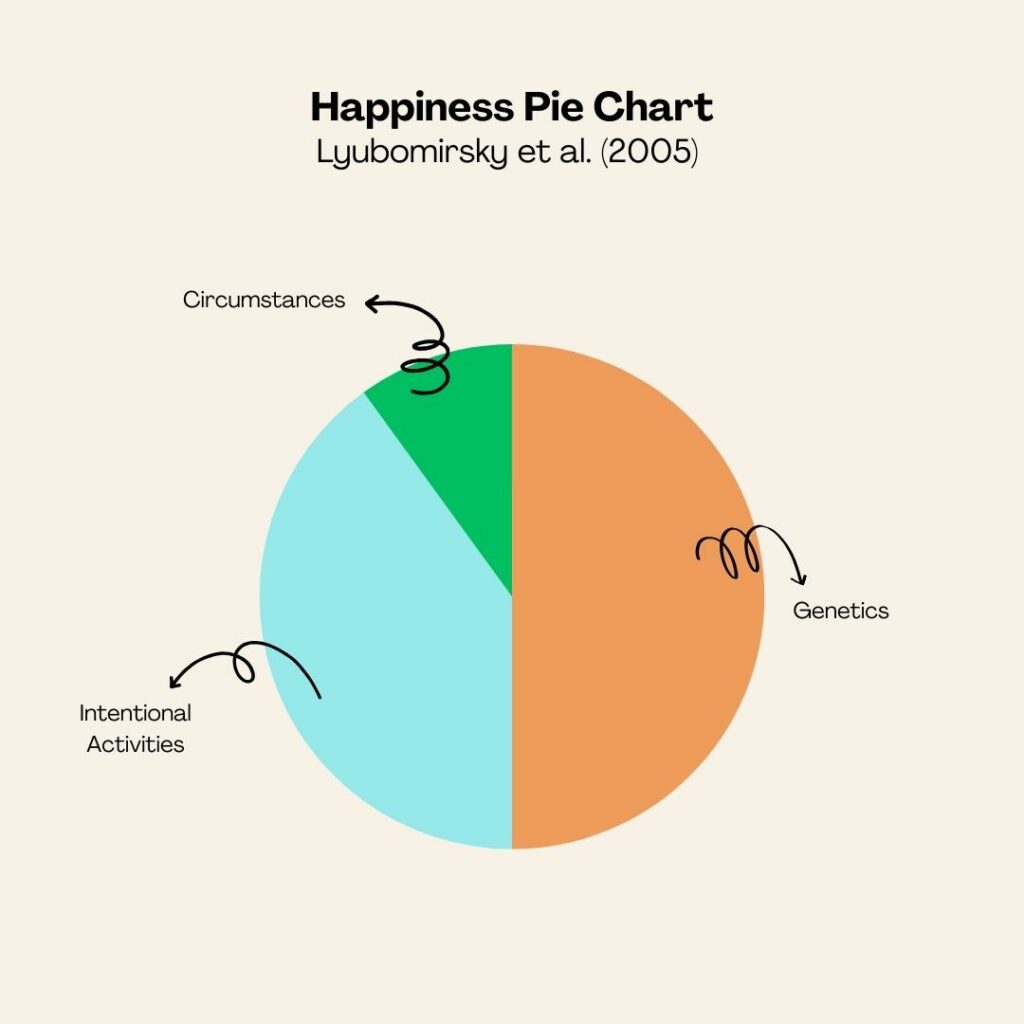Your Happiness Set Point: Is it Fixed?
Are you destined for the same level of happiness and well-being forever? Many of us believe that our happiness is static, whether it’s determined by our genes, life circumstances, or some elusive mix of fate. But is it really fixed? Recent research in the fields of psychology and epigenetics suggests that certain factors, like genetics, play a role. However, there’s a lot more within our control than we might think.
In this blog post, we will explore the concept of your happiness set point and discuss the relationships between happiness and environment, happiness and behavior, happiness and genetics, as well as the role of epigenetics. Understanding these factors can help us determine whether our happiness set point is fixed or can be changed.
What Is Happiness Set Point?
The happiness set point refers to the baseline level of happiness that individuals generally return to after experiencing positive or negative life events. It’s the natural equilibrium you revert to once the highs of a major accomplishment or the lows of a significant challenge wear off. While external factors like winning the lottery or going through a breakup can momentarily shift your mood, research suggests that most people tend to stabilize at a relatively consistent level of happiness over time. This concept is central to the set point theory of happiness, which proposes that our well-being is influenced by a combination of genetics, behavior, and environment, but remains relatively stable in the long run.
Understanding what a happiness set point is allows us to explore whether this baseline is truly fixed or if it’s possible to increase it through intentional activities and mindset shifts. While genetics play a substantial role, our actions and mindset can influence how much we oscillate around our happiness set point.
Happiness Pie Chart
According to Sonja Lyubomirsky and colleagues, about 50% of our happiness is genetically determined, 10% is influenced by life circumstances, and 40% is shaped by intentional activities. This indicates that while genes play a significant role, there’s plenty we can do to raise our happiness levels. But the question remains: Can our happiness set point be changed over time? Breaking down the factors that influence happiness may provide a clue.

Happiness and Environment
The environment we live in, including our living conditions, relationships, and workplace, has a powerful influence on happiness. However, most people believe that the relationship between happiness and circumstances is more significant than it is. Most of us believe that being rich, beautiful, or married will make us happy. However, research shows that circumstances only account for 10% of happiness. You can read more about the most common misconceptions about happiness here.
Still, it is important to note that a supportive environment can contribute to an uplift in mood. Toxic or stressful surroundings, on the other hand, can lower our emotional baseline. Changing our physical or social environment—whether by moving to a new city, building better relationships, or switching careers—can help create a more conducive space for happiness.
Happiness and Behavior
Behavior and happiness are closely intertwined. Regular habits and activities, known as happiness activities, have a lasting impact on how we feel. Research shows that 40% of our happiness is shaped by intentional activities, which means actions we consciously choose to take. Adopting positive habits, such as regular exercise, practicing mindfulness, or engaging in hobbies, can significantly boost our mood. The psychology of happiness tells us that being kind to ourselves and others, practicing gratitude, and staying optimistic are key behaviors that contribute to long-term happiness.
Happiness and Genetics
Genes and happiness are also interconnected. According to the set point theory of happiness, we are born with a natural tendency toward a certain level of happiness, determined by our genetics. However, recent studies show that genetics aren’t the full picture. While approximately 50% of our happiness may be predetermined by our genes, it’s still possible to increase happiness through intentional activities and behavioral changes.
Epigenetics and Happiness
Epigenetics refers to how external factors, such as environment and behavior, influence gene expression. This field has shown us that while genetics play a major role, they are not set in stone. Epigenetics and happiness research suggest that the role of epigenetics in happiness is undeniable. By changing our lifestyle and behaviors, we can alter the way our genes express themselves, which in turn can impact our overall happiness. This means that through the right activities, we can influence our happiness set point over time.

How to Increase Happiness Set Point
According to the theory of Lyubomirsky, approximately 50% of our happiness is determined by our genetic makeup. However, with advances in epigenetics, we now know that genes can be influenced by our behavior. This revelation means that even the 50% of happiness set by our genes can be changed by the activities and habits we choose to engage in daily.
This suggests that most of our happiness levels—and by extension, our happiness set point—depend largely on our actions, thoughts, and emotions. While circumstances play a small part, the activities we choose can increase our happiness over time. Simple happiness-boosting activities such as practicing gratitude, mindfulness, or engaging in regular exercise can positively affect our emotional well-being and increase our happiness set point.
The good news is that our happiness levels are not set in stone. We have much more control over them than previously thought. By consistently choosing behaviors that boost happiness, we can shape our well-being. The key is to make happiness a priority. Educating ourselves on what activities increase happiness is the first step. Implementing these actions daily, even for a few minutes, can gradually help us become the happiest versions of ourselves.
Building these happiness habits into daily routines helps to lock in these benefits, as repetition makes it easier to practice and sustain. Whether it’s through mindfulness practices, social connection, or physical activities, finding what works for us and turning it into a habit is vital to increasing our happiness set point over time.

Practical Ways to Increase Happiness
Now that we know our happiness set point isn’t entirely fixed, let’s discuss practical ways to increase it. To do so, we must take a look at the close relationships between happiness and habits and joy-boosting behaviors. Here are a few practical ways to increase happiness based on the psychology of happiness:
Practice Gratitude
Gratitude is a powerful happiness activity. Regularly acknowledging the good things in your life can shift your mindset and improve your happiness levels. Gratitude helps you focus on the positives, thereby increasing long-term well-being. In addition to improving mood, practicing gratitude has been shown to reduce stress and improve relationships. Taking just a few minutes a day to list things you’re thankful for can create a lasting positive impact on your happiness set point.
Engage in Physical Activity
Exercise is one of the most effective activities to boost happiness. It releases endorphins and helps reduce anxiety, making it a great way to increase happiness set point. Regular physical activity not only improves mental health but also enhances cognitive function, energy levels, and sleep quality. Whether it’s yoga, running, or even a brisk walk, any form of exercise can significantly improve your mood and overall psychology of happiness.
Develop Meaningful Relationships
Strong social connections have been proven to enhance happiness. Make time for friends and family, and nurture your relationships. Building a support system helps reduce feelings of isolation, which can negatively impact mental health. Research shows that people with stronger social bonds tend to experience less stress, higher life satisfaction, and improved emotional well-being. Investing time in developing meaningful relationships is essential for increasing your long-term happiness.

Practice Mindfulness and Meditation
Mindfulness allows you to be present and appreciate life’s small moments. Incorporating meditation into your routine can reduce stress and contribute to emotional well-being. Mindfulness techniques, such as deep breathing and body scans, have been shown to improve attention, reduce anxiety, and increase overall life satisfaction. Regular meditation not only helps to clear mental clutter but also fosters a sense of peace and contentment, raising your happiness set point.
Challenge Negative Thoughts
Cognitive Behavioral Therapy (CBT) techniques can help you recognize and change negative thinking patterns, thereby increasing happiness over time. By becoming aware of and disputing irrational thoughts, you can train your brain to adopt a more positive outlook. Challenging negative thoughts helps break cycles of pessimism and enhances emotional resilience. By applying CBT principles, you take control of your emotional responses and improve your ability to manage stress and adversity.
Invest in Experiences
Instead of material goods, invest in experiences that create lasting memories. Research has shown that experiential purchases, such as vacations or learning new skills, bring more lasting joy than material possessions. Experiences like travel, workshops, and spending time with loved ones offer deeper emotional rewards and help to combat hedonic adaptation, keeping our happiness set point elevated. These activities foster stronger connections and provide meaningful ways to savor life, making them essential for long-term happiness.
These are just a few of the many activities to boost happiness recognized by positive psychology researchers. There are countless other effective practices you can explore in our blog posts, e-books, and coaching sessions. To dive deeper into these methods and further enhance your well-being, visit https://4happyu.com/.

Conclusion
The happiness set point theory suggests that some of our happiness is predetermined by genetics. However, the good news is that much of it is influenced by our actions and behaviors. By embracing practices that boost happiness—such as gratitude, physical activity, mindfulness, and nurturing relationships—you can raise your happiness set point and enjoy a more fulfilling life. For those seeking additional support, we offer coaching to improve life, positive psychotherapy to boost well-being sustainably, and therapy/hypnosis to remove limiting beliefs/issues. You can book a session at 4HappyU.
Resources
The information in this article is grounded in scientific research. If you’re interested in specific studies, feel free to reach out to us.
For daily doses of joy, positivity, inspiration, and motivation, be sure to follow us on Instagram.
Za naše bralce v Sloveniji
Če vas zanima več o psihoterapiji in iskanju trajne sreče, preberite naslednje članke: Psihoterapija Obala, 5 ključev do trajne sreče in notranjega miru, Najboljši psihoterapevti v Sloveniji: Kako se hitro spopasti s stresom, Psiholog v Kopru: Kako odpraviti težave s psihoterapijo in RTT terapijo, in Psihoterapija Online: Prednosti in učinkovitost terapije na daljavo.


